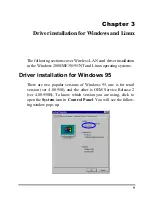
—Introduction
3
LAN Modes
Wireless LANs can be configured in one of two ways:
Ad-hoc
Networking
Also known as a peer-to-peer network, an ad-hoc
network is one that allows all workstations and com-
puters in the network to act as servers to all other
users on the network. Users on the network can
share files, print to a shared printer, and access the
Internet with a shared modem . However, with ad-hoc
networking, users can only communicate with other
wireless LAN computers that are in the wireless LAN
workgroup, and are within range.
Infrastructure
Networking
Infrastructure networking differs from ad-hoc network-
ing in that it includes an access point. Unlike the ad-
hoc structure where users on the LAN contend the
shared bandwidth, on an infrastructure network the
access point can manage the bandwidth to maximize
bandwidth utilization.
Additionally, the access point enables users on a
wireless LAN to access an existing wired network,
allowing wireless users to take advantage of the
wired networks resources, such as Internet, email,
file transfer, and printer sharing.
Infrastructure networking has the following adva n-
tages over ad-hoc networking:
??
Extended range:
each wireless LAN computer
within the range of the access point can com-
municate with other wireless LAN computers
within range of the access point.
??
Roaming:
the access point enables a wireless
LAN computer to move through a b uilding and
still be connected to the LAN.
??
Wired to wireless LAN connectivity:
the access
point bridges the gap between wireless LANs
Содержание TEW-PC16
Страница 1: ...TEW PC16 11Mbps Wireless PCMCIA Network Card User s Guide Rev 1 1...
Страница 2: ......
Страница 6: ......
Страница 29: ...Driver installation for Windows and Linux 23...
Страница 51: ...Using the Wireless Utility 45...










































